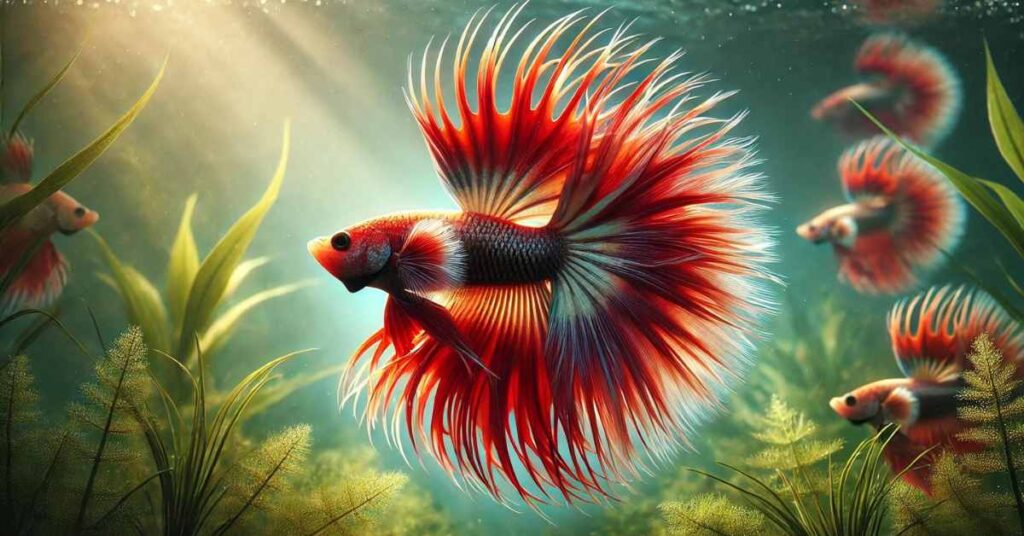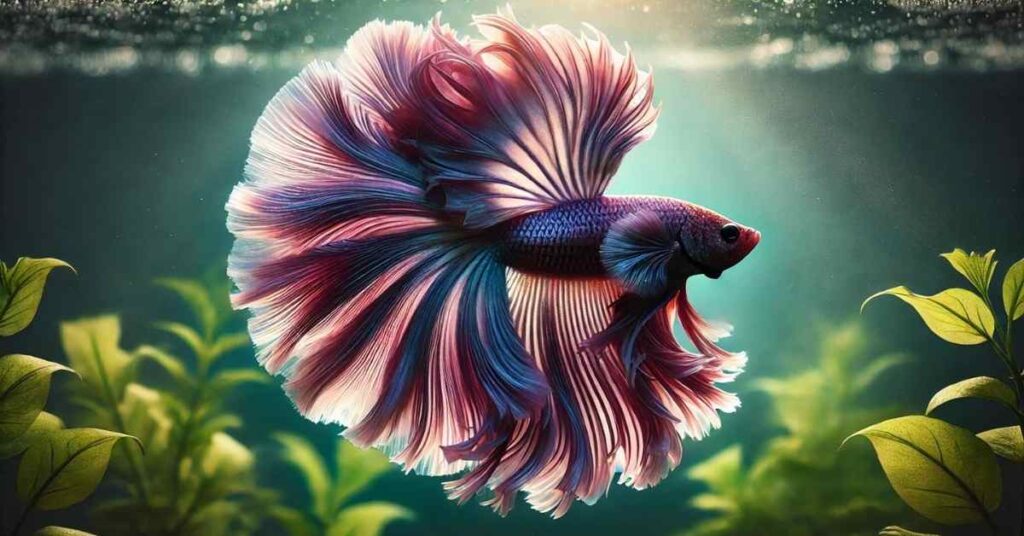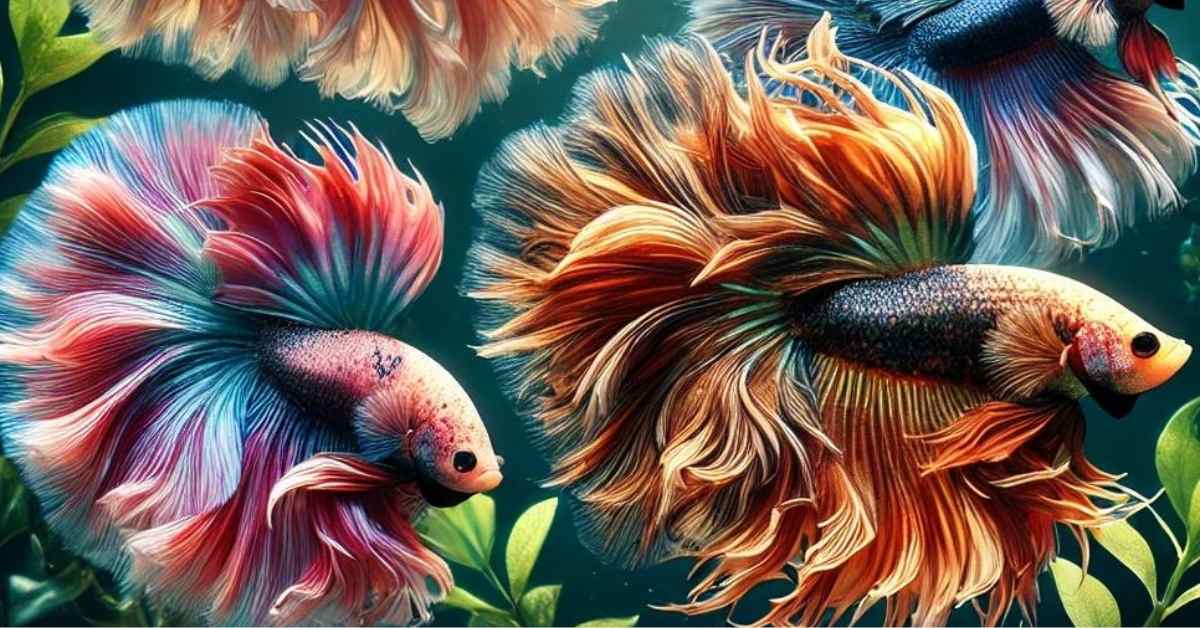Understanding Wild and Domesticated Betta Fish
Before diving into the types of Betta fish, it’s essential to differentiate between wild and domesticated varieties. Wild Betta fish are typically smaller and less colorful, while domesticated ones have been selectively bred for more vivid colors and unique tail types.
Wild Betta Fish
Wild Betta fish are found in rice paddies, ditches, and shallow bodies of water in Southeast Asia. These environments are rich in vegetation, providing Betta fish with ample food and hiding places. Unlike their domesticated relatives, wild Betta fish have shorter fins and more subdued colors like brown or green. Despite their more modest appearance, wild Betta fish are essential for maintaining the balance of aquatic ecosystems by preying on insect larvae and other small organisms.
Domesticated Betta Fish
Domesticated Betta fish are far more colorful than their wild counterparts. Over the years, breeders have developed various types of Betta fish, each with unique tail shapes, color patterns, and behavioral traits. These fish are commonly kept as pets, and their distinct looks have made them highly sought after.
Tail Types in Betta Fish
The most noticeable feature of Betta fish is their tail. The wide variety of tail shapes is a defining characteristic that sets apart different types of Betta fish. Below are some of the most popular tail types.
Veiltail Betta
The Veiltail Betta is perhaps the most common of all types of Betta fish. This Betta has long, flowing fins that resemble a veil, hence its name. The Veiltail Betta’s long tail is asymmetrical, and it often flows gracefully behind the fish as it swims.
Crowntail Betta
Crowntail Bettas are among the most striking types of Betta fish due to their unique fin structure. The rays of their tails extend beyond the fin membrane, giving the tail a spiky, crown-like appearance. These fish are often chosen for their dramatic look.
Halfmoon Betta
The Halfmoon Betta gets its name from its tail, which spreads out to form a perfect semicircle when flared. Among the types of Betta fish, Halfmoon Bettas are considered some of the most elegant. However, the large size of their fins can make them prone to injury.
Doubletail Betta
The Doubletail Betta has two distinct tail lobes instead of one, which gives this fish a unique appearance. While they are rare, Doubletail Bettas are prized by Betta enthusiasts. This tail type is often seen in multiple types of Betta fish and adds a symmetrical beauty to their appearance.
Plakat Betta
The Plakat Betta has shorter, sturdier fins compared to other types of Betta fish. Resembling the wild Betta, Plakat Bettas are strong swimmers and tend to be more active. They are favored for their natural look and durability.

Color Varieties in Betta Fish
Color is another important aspect when distinguishing between different types of Betta fish. Selective breeding has resulted in Bettas that come in a wide range of colors.
Solid Color Betta
A Solid Color Betta is a Betta fish that displays one consistent color across its body and fins. Common solid colors include red, blue, black, and white. This simple yet striking look is popular in several types of Betta fish.
Bicolor Betta
Bicolor Bettas display two distinct colors. Often, the body is one color while the fins are another. These contrasting colors make Bicolor Bettas one of the most eye-catching types of Betta fish.
Marble Betta
Marble Bettas are famous for their unpredictable and ever-changing colors. The patterns on these types of Betta fish often shift throughout their lives, which adds to their allure.
Butterfly Betta
The Butterfly Betta is recognized for its two-tone fins, where one color fades into another along the edges. These color transitions are typically seen in blue and white or red and white combinations, making this one of the most beautiful types of Betta fish.
Metallic Betta
Metallic Bettas possess an iridescent sheen that makes them look as though their scales are coated in metal. This reflective quality is found in several types of Betta fish, and it’s a popular feature among fish enthusiasts.
Behavior of Different Types of Betta Fish
Behavior is another key aspect that varies among the types of Betta fish. These fish are known for their territorial nature, especially males.
Aggression and Territoriality
Betta fish are famous for their aggression, particularly males. Most types of Betta fish will fight when kept together, especially males, which is why they are typically housed alone. This aggression is a natural survival instinct, as wild Betta fish defend their territories from rivals.
Interactive Behavior
Despite their aggressive tendencies, Betta fish are highly interactive with their environments and even with their owners. Many types of Betta fish recognize their owners and will swim to the front of the tank during feeding time or when they see movement.
Proper Care for Different Types of Betta Fish
While different types of Betta fish share similar care requirements, certain varieties may have specific needs due to their tail size or other characteristics.
Tank Size and Environment
Regardless of the types of Betta fish you own, providing adequate space is essential. Betta fish thrive in tanks of at least 5 gallons. Tanks should also include hiding spots like plants or decorations to reduce stress.
Water Temperature
Betta fish are tropical species and need water temperatures between 76°F and 82°F. All types of Betta fish benefit from stable, warm environments, and fluctuating temperatures can cause stress or illness.
Diet
All types of Betta fish require a high-protein diet. They are carnivorous and thrive on specially formulated Betta pellets, freeze-dried foods, and occasional treats like bloodworms. Overfeeding can lead to health problems, so it’s crucial to maintain a balanced diet.

Health Issues in Betta Fish
Like any other fish, Betta fish can suffer from various health problems. Different types of Betta fish may be more or less prone to certain issues, depending on their tail type and environment.
Fin Rot
Fin rot is a common condition, especially in long-tailed types of Betta fish like the Veiltail or Halfmoon. It occurs when the water quality is poor, and bacteria attack the fish’s fins. Proper tank maintenance can help prevent fin rot.
Swim Bladder Disorder
Swim bladder disorder affects many types of Betta fish and causes them to float uncontrollably or sink to the bottom of the tank. This condition is often caused by overfeeding or constipation. Fasting the Betta for a day or two can help alleviate this issue.
Environmental Impact of the Betta Fish Trade
The popularity of Betta fish has led to widespread breeding, which can have environmental and ethical implications. Understanding the environmental impact of breeding different types of Betta fish is crucial for maintaining sustainable practices.
Overharvesting and Habitat Destruction
In some regions, wild Betta populations are threatened by overharvesting and habitat destruction. While most types of Betta fish sold today are bred in captivity, the loss of natural habitats due to pollution, agriculture, and urbanization continues to endanger wild populations.
Ethical Breeding Concerns
Selective breeding of certain types of Betta fish for traits like long fins or specific colors can lead to genetic health problems. Breeding practices should prioritize the health of the fish rather than extreme physical traits.
Conservation Efforts for Betta Fish
Conservation efforts are essential for protecting wild Betta populations and ensuring the long-term health of all types of Betta fish.
Habitat Protection
Conserving wetlands and other habitats in Southeast Asia is vital for protecting wild Betta species. These areas are essential not only for wild types of Betta fish but also for the broader ecosystem.
Captive Breeding Programs
Sustainable captive breeding programs that prioritize the health of the fish over extreme aesthetic traits can reduce the need for wild-caught specimens and help preserve the integrity of various types of Betta fish.
Conclusion: Appreciating the Beauty and Importance of Betta Fish
Betta fish are more than just ornamental pets. The many types of Betta fish offer a fascinating look at the diversity within this species, from their various tail shapes to their vibrant colors and unique behaviors. Whether you’re a new Betta owner or an experienced enthusiast, understanding the needs and environmental impact of Betta fish is essential for their care and conservation.
Each of the types of Betta fish plays a role in their ecosystem, both in the wild and in captivity. By learning more about these fish and advocating for sustainable practices, we can ensure that these remarkable creatures continue to thrive for generations to come.
Read More: Are Pink Dolphins a Real Thing? An In-Depth Look at the Mysterious Mammals

